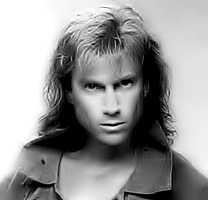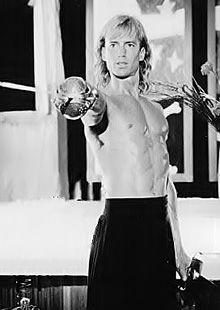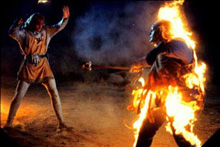|
|
Before requesting to
have your film reviewed, please make sure to
read the Film Submission FAQ in the Submission
Info section and then contact
the editor to request the review and get the
shipping address.
Rogue Cinema is always on the lookout for
new writers to join our regular staff of
volunteers. If you would like to join the Rogue
Cinema team, check out the Submission FAQ and
then contact
the editor to discuss your proposed
submission(s).
| |
 | | | |
|
 |
 |
 |
 |
 |
An Interview with Robert Chapin - By David
Stephenson
Posted on Wednesday, November
01 @ Mountain Standard Time by Duane
Robert Chapin is one of the movie industry’s top
fight co-ordinators with over 20 years of experience in
this often breathtaking and dangerous field. In this
interview he discusses working with such names as
Spielberg and Raimi, Robin Williams and even David
Hasselhoff, and sheds light on the dangers and rewards
of being one of Hollywood’s top performers.
* * *
 Firstly, could you introduce
yourself to our readers who may not be familiar with
your work? Firstly, could you introduce
yourself to our readers who may not be familiar with
your work?
Born and raised in
Miami, Florida where I got into stage combat and
swordplay just out of high school (1982). I joined a
group called the Royal Chessmen that performed living
chess games at local renaissance fairs. I had such a
blast, I joined a jousting group called The Knights
Arrant, did some swashbuckling at a theme park called
Pirates, and helped pay my way through college by
performing swordfights at a dinner theater called
Shakespeare's Tavern.
What started out as a hobby
quickly became a profession when I made my way to
Hollywood in 1987. I was hired to perform swordfights on
several feature films such as Hook and Army of Darkness.
Within five years, I had written and starred in my own
swashbuckling feature film called Ring of Steel, and I
have been performing and choreographing swordplay in
Hollywood ever since.
You're
known as a highly skilled fight choreographer - what
drew you to that profession? How does someone get into
that type of career?
First off,
thanks for the "highly skilled" comment. Fight
choreography is a rather subjective profession in
Hollywood. There are plenty of studio executives that
have no idea what good choreography is.
I wasn't
really drawn into swordplay as a profession, it was just
plain fun. That seems to be the secret in Hollywood;
you’ve got to love what you do. Beyond that, I trained
with whoever I could in everything from swordplay to
gymnastics and martial arts including Judo, Tae Kwon Do,
Aikido, Wushu, Capoeira, and Kali. And then you have to
go where the jobs are. If you want to work in Hollywood,
that's where you’ve got to
be.
Yours is described as a
dangerous profession - have there been any occasions
where you've ever been in serious peril? Ever get
seriously hurt?
I've seen some
serious injuries and I've heard fight choreographers
boast about their scars, which makes no sense if they're
trying to convince you how good they are. After 25
years, I'm lucky enough not to have any scars or major
injuries.
However, every fight scene has its own
inherent dangers, and an accident can happen in the
blink of an eye. Only rehearsal and training can help
you minimize the risk.
What's the
biggest injury you've ever received on set? Is the job
really as dangerous as people make it out to
be?
I tore my ACL (knee) in fight
rehearsal doing a flip with a half twist off a
minitramp. Like I said, it takes just a blink of an eye,
and yes, it can be extremely dangerous. I've seen some
serious injuries including a sword cut right across a
person's face. There are also stories of big action
stars with even bigger attitudes who don't mind if a
stuntman gets stabbed or loses an eye.
I think
Brandon Lee's death was a big wake-up call for
Hollywood.
Who's the best actor
you've ever worked with in terms of picking up the
skills needed to pull of those high-impact fight
scenes?
Robin Williams on Hook.
Even though he had a stunt double, he jumped right into
a complex fight sequence and had it down in a matter of
minutes. However, he already had the skills thanks to
his Juliard training. It pays to be prepared, otherwise
it's virtually impossible to make someone look like an
expert swordsman
overnight.
Looking through your
credits, you worked as choreographer on Sam Raimi's Army
Of Darkness - what's he like to work with? Any stories
to tell?
Army of Darkness was a bit
of a challenge for us sword guys - since we were working
on Hook at the same time. We'd get up at 6am and work
all day on Hook, then drive up to the valley to work all
night on Army of Darkness. We slept between
takes.
Sam is a brilliant director, but he was a
bit frustrated with the scope of the film. We had some
major battles with precise timing that didn't always
work to his liking. At some point, he threatened to
finish off one of the knights himself.
What's
more, the film almost wasn't released thanks to politics
and financing. We were called back after almost a year
to finish filming at the Introvision
studios.
Raimi is something of a
cult hero to some of our readers - did you notice any
difference in his working style to, say, the time you
worked with Spielberg on
Hook?
Spielberg appeared to be lost
on Hook. I don't know what politics he was dealing with,
but it seemed he had no idea what he was shooting from
one day to the next. An insane amount of money was spent
and lost on that film.
Sam, however, had fairly
elaborate storyboards and was coming from a low budget
background, so he made the best of his time and
budget.
 Did
you get a chance to work with Bruce Campbell? If so, in
what capacity? What's he like
off-camera? Did
you get a chance to work with Bruce Campbell? If so, in
what capacity? What's he like
off-camera?
I didn't get to work
with Bruce directly, but I was there for his training.
He's an extremely hard working actor and quite
humble.
Is his chin really THAT
big in real life?
The camera adds
10 pounds.
You've worked on
Baywatch - what was your role there? Do you find
television work differs to that of working for the big
screen?
I doubled David Hasselhoff
for an episode. They needed someone to climb a sixty
foot cliff in Zuma called Point Dume and do a fight
scene at the top. I told them I did that regularly on
the weekends for fun, but it was nice to get paid for
it.
Some say that television work is faster
paced. I think it depends on the production. We shot
Ring of Steel in two weeks, which is pretty crazy for a
feature film. The big difference is the attitude. TV
actors are always trying to make it to the big screen.
However, that's changing these days with a lot of star
actors making the transition back to
TV.
What's it like working with
David Hasselhoff?
Nice guy, hard
working. I actually doubled him before Baywatch on a
show he produced called Ring of the Musketeers. It was a
cross between the Three Musketeers and Knight Rider -
modern day descendants of the musketeers fighting crime
with swords. Among the cast were Cheech Marin and John
Rhys Davies. Very silly stuff. To this day, he remembers
me as the guy who coached him to swordfight. He loves
that stuff.
Have you ever had
difficulty working around the limitations of various
costumes or make-up? If so, how did you get around these
obstacles?
There's a saying in the
industry. Given the chance, your costume and props will
always conspire to kill you. Typically it's the shoes
that are too slick, wigs or helmets that flop around and
blind you, or robes that get wrapped around you just
when you have to block a potentially lethal sword
attack. You just try to do the best you can and learn a
few tricks along the way, like mopping the floor with
soda to make it sticky. Also, get to know the wardrobe
person early so you can head off any
disasters.
The only problems I've ever had with
makeup is when you sweat greasepaint into your eyes -
blinding you, or when fake blood gets all over your
hands which is made of slick Karo syrup. On one occasion
I saw a sword fly right out of an actor's hands straight
towards a stunned camera
crew.
One of the biggest changes
to the stunt industry is the introduction of CGI stunts.
What are your thoughts on this - do computer graphics
enhance or detract from a film?
I
actually just wrote an article on this subject for
Inside Stunts Magazine (http://www.insidestunts.com/).
CG is just a tool, and it can be used to either benefit
a film (as in Lord of the Rings), or drag it down with
crappy effects. This is true of any aspect of film:
acting, story, photography, directing, editing...
Everything has the potential to enhance or detract from
a film.
That being said, CGI is an amazing tool,
capable of practically anything. I think we will
continue to be astounded by the possibilities in the
coming years. Likewise, we will continue to be astounded
by how bad CG can be, which is why we hear complaints
from audiences and stuntmen who are opposed to the use
of CGI.
Does the advent of CGI
make life for fight choreographers / stunt men easier or
harder? Is there less work now this technology is
accessible?
In my article, I talk
about CG as a tool for stuntmen - no different from an
air bag or ratchet. Stunts can be made safer by removing
wires and rigs, fights can be sped up, pyro can be added
in post, a bluescreen can be used to composite a
stuntman on the edge of a cliff or building. You don't
even have to look like the star anymore when your head
can be replaced with CG.
It's true that there are
some instances where a stuntman can be replaced entirely
with CG, and full CG battle sequences have been created
for films like Lord of the Rings, but even visual
effects artists will tell you that it's always better if
you can use a real stuntman. Regardless of where the
technology is going, CG will never replace stuntmen.
Actually, CG has created new jobs for stuntmen in the
areas of motion capture for feature films, TV, and video
games.
Popular films like The
Matrix have seen the use of techniques like wireplay
etc. becoming ever more common - what do you think of
these techniques?
Like CGI, wire
work can greatly enhance action sequences if used
correctly. Unfortunately, it is overused quite
frequently which can be distracting and downright
silly.
What do you think of the
Asian world of action cinema and the extreme lengths
some of their professionals go to? Some describe the
lengths those stars go to as insane; what are your
thoughts on that?
Jackie Chan's
biography (“I Am Jackie Chan”) gives you a good idea why
Asian stuntmen are willing to take extreme risks. There
are at least a dozen other guys waiting on the fence to
take your place in case you can't do a stunt or get
hurt.
Regardless of what we think in the states,
we have to step up our game to compete with the Asian
market and hopefully try to make it safer in the
process.
A few years back there
was an outcry amongst stunt men who protested against
what they saw as a lack of respect from the rest of the
film industry. Complaints included the lack of an Oscar
for stunts and fight choreography. What are your
thoughts on this?
I personally
think the Oscar Awards are long enough, but yeah, I
think that stunt coordinators should at least deserve
some sort of recognition. As it is, stuntmen have their
own awards show called The World Stunt Awards (http://www.worldstuntawards.com/), and
it's way cooler than the Oscars. The first year I
attended, Arnold Schwarznegger (with the help of a stunt
double) made an entrance by jumping out of a helicopter
and falling through the roof of the
theater.
 Who
do you think are the best fight / stunt professionals in
the business right now? Is there anyone out there whose
work you find particularly
inspiring? Who
do you think are the best fight / stunt professionals in
the business right now? Is there anyone out there whose
work you find particularly
inspiring?
There's a lot of up and
coming choreographers who are embracing CG enhanced
stunts, which is where the industry is going. I've seen
a lot of older coordinators reluctant to dive into the
new technology, which is understandable.
As a
swordsman, I'm keeping my eye on Richard Ryan, who
recently choreographed swordfights on Troy. He has an
extensive background in choreography and is willing to
use whatever tools out there to help tell a
story.
If any of our readers were
considering taking up a career in fight choreography and
stunts, what would your advice be to
them?
I actually have a page I put
together online giving advice to aspiring stunt
professionals (www.robertchapin.com/action_faq.html).
The best advice I ever got was from my first stage
combat group, the Royal Chessmen. Rule #1, don't hurt
anyone, and Rule #2, don't get hurt. I would add that if
you want to find work as a stuntman, train with the
people who are working in the industry. And above all,
don't take it too
seriously.
You've previously
written that many young stunt professionals join the
Screen Actors Guild and then find they don't have the
experience to make it at that level - what are your
thoughts on the SAG, its prices, and the limitations it
can sometimes present?
I'm actually
registered as SAG Financial Core, which allows me to
work non-union productions. Many aspiring stuntmen (and
actors) think that getting your card will immediately
get you work, which isn't the case. SAG does not find
work for their members, and what's worse, you can no
longer develop your skills or add to your credit list by
doing non-union work. SAG can also fine you for doing
non-union work, so you better be sure you're ready to
stick to doing union
shows.
What's next for Robert
Chapin?
I'm looking to combine my
visual effects background with stunts and fight
choreography, perhaps even directing. I have a few
projects of my own in the wings, but regardless of what
you have planned, this town always has a way of
surprising you. Twenty years ago, I had no idea I'd star
in my own feature film or find work as a professional
fight choreographer. Hollywood can be a lot of things,
good and bad, but one thing's for certain, it's never
dull.
Wednesday, November 01 @ Mountain
Standard Time Interviews |
| |
 |
 |
 |
 | |
|
|
 |
 |
 |
 |
| "Login" | Login/Create an Account | 0
comments |
|
|
| The comments
are owned by the poster. We aren't responsible for their
content. | |
 |
 |
 |
 |
 |
 |
 |
 |
No Comments Allowed for Anonymous, please register |
 |
 |
 |
 | |
|

